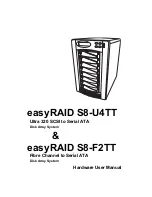
4
easyRAID S8
Serial ATA Disk Array Systems
1
O
ve
rv
iew –
Un
de
rs
ta
nd
in
g RAID
RAID 3
In RAID 3, data is divided into pieces; the parity of these pieces is calculated; and the pieces are
written to separate disks in parallel with the writing of the parity to a dedicated disk. This process
is called striping with parity. The parity disk stores redundant information about the data on other
disks. If a single disk fails, then the data on the other disks is used to regenerate the data on the
failed disk. Striping delivers a high access rate and parity delivers good data availability. The sin-
gle parity disk is a bottleneck on sequential writes, since parity must always be written to the sin-
gle parity disk.
RAID 3 consists of two or more disks used for data and one disk used for fault tolerant data. The
total capacity of RAID 3 is the sum of the capacities of each data disk. Add disks until the desired
capacity is reached, then add one more disk for fault tolerance.
RAID 3 is used by the following applications that request large amounts of data sequentially:
• Processing of graphical or video images
• Processing of CAD/CAM files
RAID 3 has the following distinctive features:
• Excellent performance for data transfer characteristics
• Not well suited for transaction processing or other I/O request intensive applications













































